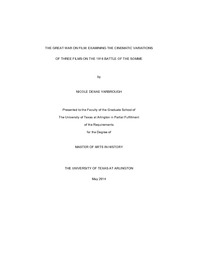
ATTENTION: The works hosted here are being migrated to a new repository that will consolidate resources, improve discoverability, and better show UTA's research impact on the global community. We will update authors as the migration progresses. Please see MavMatrix for more information.
Show simple item record
| dc.contributor.author | Yarbrough, Nicole Denae | en_US |
| dc.date.accessioned | 2014-07-14T20:33:40Z | |
| dc.date.available | 2014-07-14T20:33:40Z | |
| dc.date.issued | 2014-07-14 | |
| dc.date.submitted | January 2014 | en_US |
| dc.identifier.other | DISS-12714 | en_US |
| dc.identifier.uri | http://hdl.handle.net/10106/24501 | |
| dc.description.abstract | Propaganda has been an integral part of human history, and while the documentation of conflict through film began in the middle of the nineteenth century, it was not until the First World War that the production and distribution of war films as propaganda became a mass phenomenon. Moving images of the war proliferated in all Western countries at an unprecedented rate. This thesis explores the role of wartime propaganda films in Britain, France, and Germany during the First World War by assessing the achievements and missteps of cinematic variations on the 1916 Battle of the Somme. Although these films achieved varying degrees of success as both propaganda films and war documentaries, they failed to alter the fundamental opinion of the masses. Rather, they strengthened and reinforced existing attitudes about the war. More importantly, the films shaped the way people would remember both the battle and the war in future generations. | en_US |
| dc.description.sponsorship | Reinhardt, Steven G. | en_US |
| dc.language.iso | en | en_US |
| dc.publisher | History | en_US |
| dc.title | The Great War On Film: Examining The Cinematic Variations Of Three Films On The 1916 Battle Of The Somme | en_US |
| dc.type | M.A. | en_US |
| dc.contributor.committeeChair | Reinhardt, Steven G. | en_US |
| dc.degree.department | History | en_US |
| dc.degree.discipline | History | en_US |
| dc.degree.grantor | University of Texas at Arlington | en_US |
| dc.degree.level | masters | en_US |
| dc.degree.name | M.A. | en_US |
Files in this item
- Name:
- Yarbrough_uta_2502M_12714.pdf
- Size:
- 3.820Mb
- Format:
- PDF
This item appears in the following Collection(s)
Show simple item record


